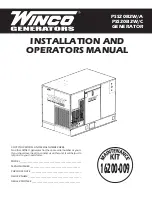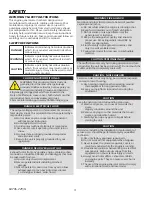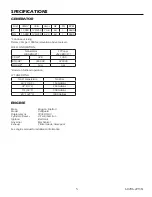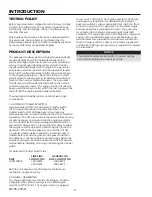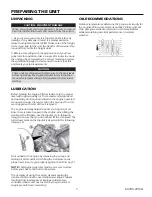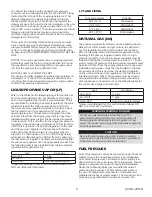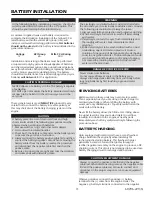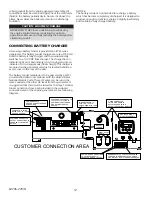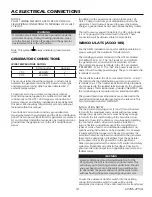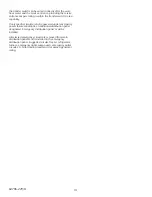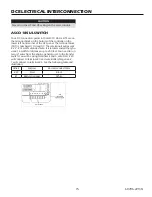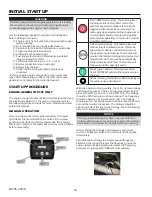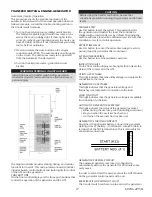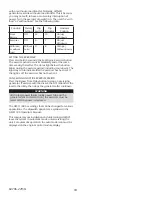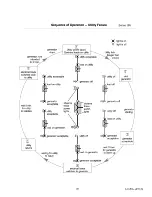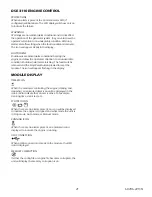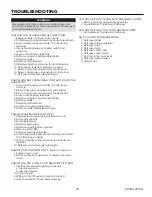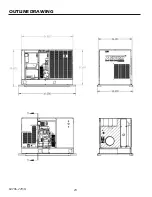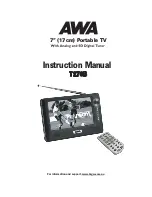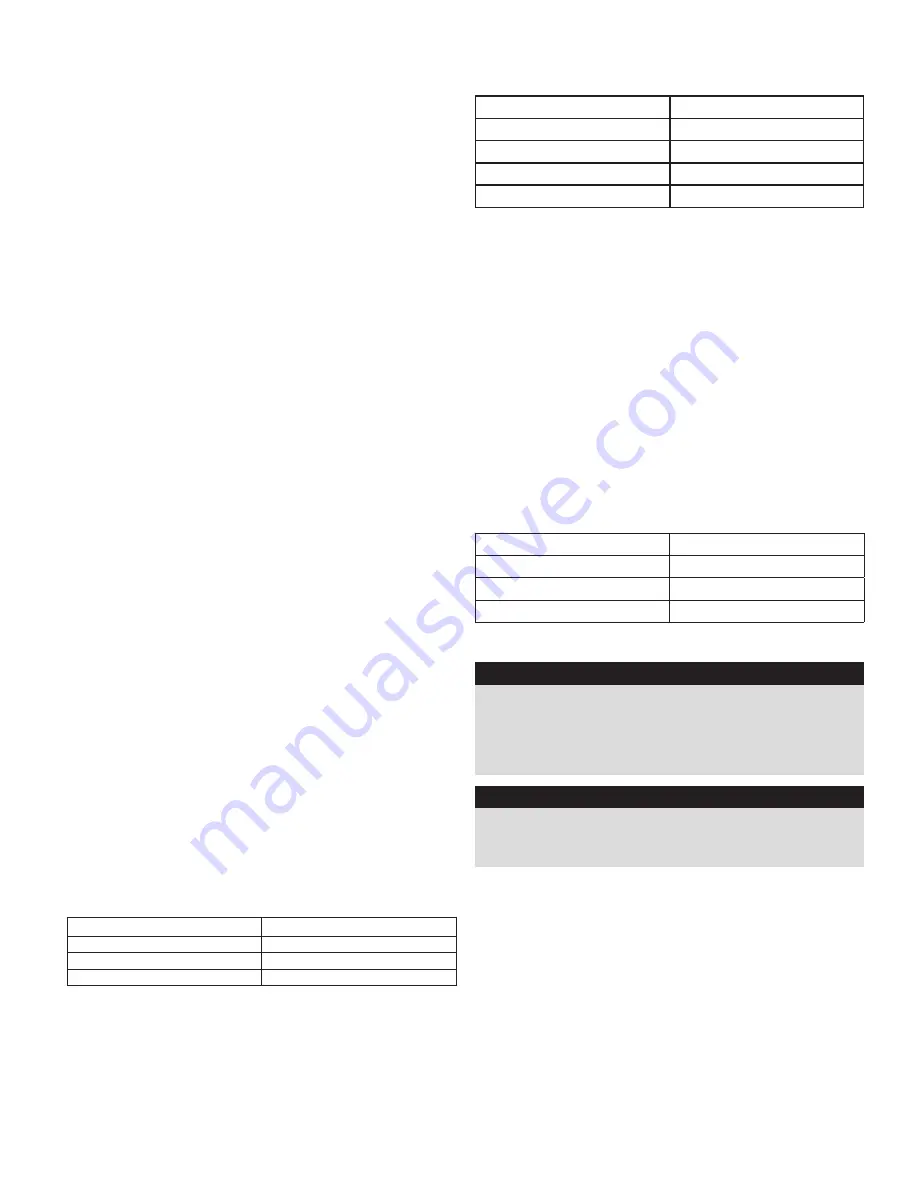
9
60706-229/G
To connect the fuel line to the generator set you will
connect your incoming fuel line to the 3/4 inch NPT fitting
located on the left side of the engine-generator set. This
fitting is shipped with a plastic plug installed to insure
the fuel system stays clean. For all vapor fuel systems the
delivery pressure of the fuel to the fuel solenoid on the unit
must be four to six ounces psi (per square inch) or 7 to 11
inches W.C. (water column). These fuel pressures are critical;
failure to provide the proper pressure can cause many
problems ranging from a unit that will not start to causing
damage to the fuel system.
These units are normally tested on Natural Gas and will
have a tag hanging on the fuel hose indicating on what
fuel your unit was factory tested. If you are running on LP
or have to change fuel types at any time, see information
on page 8 on NG/LP CONVERSION. INSTALLING THE FUEL
LINE
NOTICE: The engine generator sets are properly adjusted
before they leave the factory. A tag is attached to the unit
that specifies the fuel, natural gas (NG) or propane vapor
(LP) that the unit was set up and tested on.
NATURAL GAS or LP VAPOR PIPE SIZE
Size of pipe normally required for generators operating on
natural gas or LP vapor. Unit location will determine the
size of fuel line that is required to supply the engine with a
constant fuel pressure and volume.
LIQUID PROPANE VAPOR (LP)
Refer to the tables on the following pages for fuel line size
and recommended tank size. For distances of 100 feet or
over, a two regulator fuel system is recommended. This is
accomplished by installing a primary regulator at the tank
which will reduce the tank pressure down to 10 to 15
lbs. A low pressure regulator is installed to further reduce
the fuel pressure to the required four (4) to six (6) oz.
operating pressure. This low pressure regulator must be
at least 10 feet from the engine generator set; any closer
installation will require a larger line be installed to provide
a fuel reservoir. This is also true for the single low pressure
regulator, it should also be a minimum of 10 feet from the
unit. If this is not done, the demand regulator on the unit
and the pressure regulator in the fuel line will interfere
with each other. When the two (2) regulator system is
used on LP, a fuel line size of 1/2 to 5/8 inch is generally
adequate for distances up to 300 feet from the primary to
the low pressure regulator. Consult your local fuel supplier
for your exact requirements . The appropriate line size from
the following table is then installed from the low pressure
regulator to the generator set.
Feet*
Size of pipe
Up to 25 ft
¾” pipe
25 - 100 ft
1” pipe
Over 100 ft
Use a two regulator system
*Allow an additional 3 feet for each standard elbow. DO
NOT use ‘street ells’ (restrictive).
LP TANK SIZING
Tank Temperature
Tank Size
60° F (16° C)
150 Gallons
32° F (0° C)
250 Gallons
0° F (18° C)
500 Gallons
-20° F (-29° C)
1000 Gallons
NATURAL GAS (NG)
The primary regulator (fuel meter) on the building should
deliver the correct volume and pressure to the generator
set. This regulator must be sized to deliver the required
BTU’s to the generator set and all other appliances in the
building. If the primary regulator (fuel meter) is a high
pressure regulator, then a low pressure regulator must be
installed to bring the pressure down to 4-6 oz. (7-11 inches
water column) of pressure. This low pressure regulator must
be at least 10 feet from the engine generator set; any closer
installation will require a larger line be installed to provide
a fuel reservoir. If this is not done, the demand regulator
on the unit and the pressure regulator in the fuel line will
interfere with each other. This regulator must be sized to
accommodate the demand of the generator set and any
other appliance connected to it. See the following table for
the correct size of pipe to be installed.
Feet*
Size of pipe
Up to 25 ft
¾” pipe
25 - 100 ft
1” pipe
Over 100 ft
Use a two regulator system
*Allow an additional 3 feet for each standard elbow. DO
NOT use ‘street ells’ (restrictive).
WARNING: PERSONAL DANGER
Do not use galvanized pipe in fuel line runs. The
galvanized coating can become eroded and flake off,
causing possible obstructions in the regulator or fuel
valve. The results could range from inoperative engine to
hazardous fuel leaks.
CAUTION
Be careful when sealing gas joints. Excessive sealing
compound can be drawn into the solenoid, regulator or
carburetor causing an engine malfunction.
FUEL PRESSURE
Correct fuel pressure cannot be stressed enough. The most
common cause for inoperative systems is an inadequate
or incorrect fuel pressure. Performance of the engine is in
direct relation to the correctness of the fuel system. Shown
below is a diagram of a typical LP vapor fuel installation.
Notice the following tables give two different units of
measuring fuel pressure. The first and most accurate is
the use of a simple water manometer. A manometer is
calibrated in inches of water column . The second is with a
pressure gauge calibrated in ounces per square inch.
Summary of Contents for PSS20B2W/A
Page 19: ...19 60706 229 G...
Page 24: ...24 60706 229 G OUTLINE DRAWING...
Page 25: ...25 60706 229 G PAD LAYOUT 60706 229 23 12270 01 60706 229 ET A ENGINE GENERATOR SET PAD LAYOUT...
Page 26: ...26 60706 229 G AC AND DC GENERATOR SCHEMATIC...
Page 27: ...27 60706 229 G AC WIRING SCHEMATIC PSS20 3 A PSS20 17 A PSS20 18 A PSS20 4 A...

